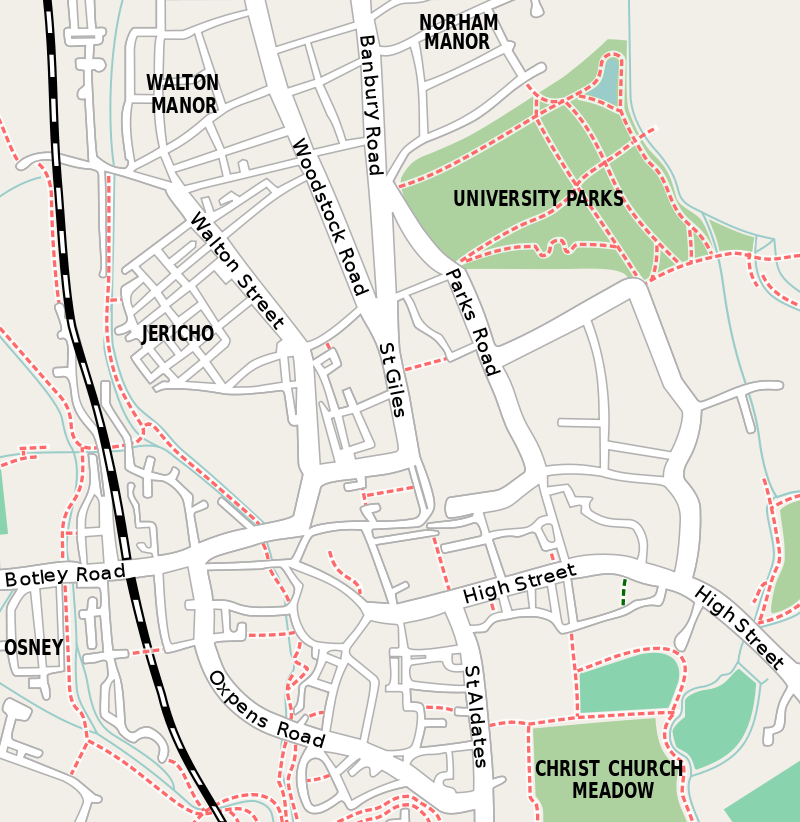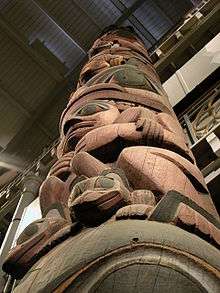Pitt Rivers Museum
The Pitt Rivers Museum is a museum displaying the archaeological and anthropological collections of the University of Oxford in England.[2] The museum is located to the east of the Oxford University Museum of Natural History, and can only be accessed through that building.
Pitt Rivers Museum interior, 2015 | |
 Pitt Rivers Museum | |
| Established | 1884 |
|---|---|
| Location | Parks Road, Oxford, England |
| Coordinates | 51.7586°N 1.2550°W |
| Type | University museum of archaeology and anthropology |
| Visitors | 502,000 (2018)[1] |
| Website | http://www.prm.ox.ac.uk |
The museum was founded in 1884 by Augustus Pitt Rivers who donated his private collection to the University of Oxford with the condition that a permanent lecturer in anthropology must be appointed. Museum staff are involved in teaching Archaeology and Anthropology at the University even today. The first Curator of the museum was Henry Balfour. A second stipulation in the Deed of Gift was that a building should be provided to house the collection and used for no other purpose. The University therefore engaged Thomas Manly Deane, son of Thomas Newenham Deane who, together with Benjamin Woodward, had designed and built the original Oxford University Museum of Natural History building three decades earlier, to create an adjoining building at the rear of the main building to house the collection. Construction started in 1885 and was completed in 1886.
The original donation consisted of approximately 22,000 items;[3] this has now grown to 500,000 items, many of which have been donated by travellers, scholars and missionaries.
On March 17, 2020, the museum shut indefinitely due to the COVID-19 pandemic.[4]
Organization

The museum's collection is arranged typologically, according to how the objects were used, rather than according to their age or origin. This layout owes a lot to the theories of Pitt Rivers himself, who intended for his collection to show progression in design and evolution in human culture from the simple to the complex. Whilst this evolutionary approach to material culture is no longer fashionable in archaeology and anthropology, the museum has retained the original organisation of the displays. The display of many examples of a particular type of tool or artifact, showing historical and regional variations, is an unusual and distinct feature of this museum.
The museum has a high density of objects on display, and the displays are changed periodically.
At 11.36m high the Haida totem pole is the largest object on display in the museum. From a Haida community, it originally stood outside Star House in the village of Old Massett (Haida name Uttewas), on Graham Island, in British Columbia, Canada. The house was built around 1882 and belonged to chief Anetlas (c.1816–1893). The pole came to the Pitt Rivers Museum in 1901.[5]
Expansion
In 2004, the museum received £3,700,000 from the Higher Education Funding Council for England (HEFCE) to build a research annex adjoining the museum. Building work was completed in 2007, bringing the academic staff of the museum back to the site, and providing a laboratory for conservation of the specimens. The annex will not affect the Victorian displays of the museum.
The second phase of development began on 7 July 2008 necessitating the closure of the museum and galleries. The museum reopened on 1 May 2009.[6] In this work, the 1960s exhibition gallery was dismantled, restoring the original view through to the museum's totem pole. Original display cases were returned to their original place at the front of the museum. The space upstairs vacated by these cases provides additional space for a Clore Duffield Education Centre. A new entrance platform allows visitors to enter on the same level as the Oxford University Museum of Natural History and improves access for wheelchair users and parents with pushchairs. The entrance platform provides re-located shop and reception areas. An environmental control system has also been installed.
Awards
The Pitt Rivers Museum, along with the Oxford University Museum of Natural History, won The Guardian newspaper's award for Family Friendly Museum of 2005.
Controversy
Like many museums, the Pitt Rivers has struggled with the origins[7] of many of the items in its collection. The museum is working on "cultural decolonisation," such as meeting with originating communities to address errors and gaps in the information it stores, and to discuss repatriation.
Notable people
- Clare Harris, curator for Asian Collections
See also
- Augustus Pitt Rivers
- Anthropology
- Museums of the University of Oxford
- Oxford
- Oxford University, of which the museum is a department
- Ashmolean Museum
- Oxford University Museum of Natural History
- Museum of the History of Science, Oxford
References
- "ALVA - Association of Leading Visitor Attractions". www.alva.org.uk. Retrieved 27 July 2019.
- "Pitt Rivers Museum". Culture 24, UK. Retrieved 13 March 2011.
- "Dan Hicks 2013. Characterizing the World Archaeology Collections of the Pitt Rivers Museum. In D. Hicks and A. Stevenson (eds) World Archaeology at the Pitt Rivers Museum: a characterization. Oxford: Archaeopress".
- "Ashmolean, Pitt Rivers and other museums SHUT over coronavirus". Oxford Mail. Retrieved 25 March 2020.
- "Pitt Rivers Museum: The Haida Totem Pole". Pitt Rivers Museum: The Haida Totem Pole. Retrieved 29 October 2015.
- Campbell-Johnston, Rachel (29 April 2009). "The Pitt Rivers Museum in Oxford reopens". The Times. Retrieved 13 March 2011.
- Koshy, Yohann (4 December 2018). "Hey, that's our stuff: Maasai tribespeople tackle Oxford's Pitt Rivers Museum". The Guardian. ISSN 0261-3077. Retrieved 24 July 2019.
Further reading
- Baumgarten, Lothar. Unsettled Objects. Edition of Guggenheim Magazine published in conjunction with the exhibition AMERICA Invention. New York: Solomon R. Guggenheim Museum, 1993. (Contains photographic documention of the Pitt Rivers' collection and essays on ethnographic collecting)
- Chapman, William Ryan. "Arranging Ethnology: A. H. L. F. Pitt Rivers and the Typological Tradition." In Objects and Others: Essays on Museums and Material Culture. Edited by George W. Stocking, Jr. Madison: University of Wisconsin Press, 1985.
- Cranstone, B.A.L. and Steven Seidenberg. The General's Gift: A Celebration of the Pitt Rivers Museum Centenary, 1884–1984. Oxford: JASO, 1984.
- Hicks, Dan and Alive Stevenson (eds) 2013. World Archaeology at the Pitt Rivers Museum: a characterization. Oxford: Archaeopress. World Archaeology at the Pitt Rivers Museum



